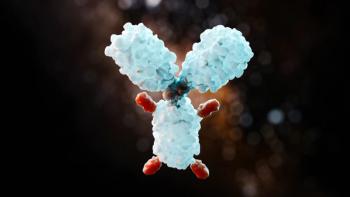
Long-Term Follow-Up of Ibrutinib in CLL/SLL: Insights and Outcomes
Follow-up data reveal 10-year impact of ibrutinib in treatment of patients with chronic lymphocytic leukemia or small lymphocytic lymphoma (CLL/SLL).
Chronic lymphocytic leukemia or small lymphocytic lymphoma (CLL/SLL) is the most prevalent low-grade B-cell leukemia found in the United States and Europe, affecting nearly 4.9 per 100,000 individuals per year.1 In the past decade, research into the use of bruton tyrosine kinase (BTK) inhibitors marks a shift toward the use of targeted therapies over chemotherapy, immunotherapy, and combination regimens, which can be significantly more toxic treatments. Since the FDA approval of ibrutinib (Imbruvica; Janssen Biotech, Inc) use in the front-line, BTK inhibitors have become a treatment of significant interest in clinical research, demonstrating capabilities in improved efficacy, safety, and tolerability for patients.1
CLL/SLL is a slow-growing malignancy characterized by the abnormal growth and proliferation of mature but immunologically dysfunctional B lymphocytes located in the blood, spleen, lymph nodes, and bone marrow. CLL and SLL are nearly identical from a pathologic standpoint; however, they are differentiated based on where the malignant cells are found in the body. The cause of this disease is largely unknown; but researchers believe genetic factors may be the underlying mechanisms increasing risk of CLL/SLL. Additionally, there are reports that exposure to environmental factors, such as pesticides, benzene, radiation and tobacco, can also increase an individual’s risk.2
Typical treatment for CLL/SLL includes chemotherapy, immunotherapy, and combination regimens, and growing research into BTK inhibitors shows increased success in treating patients with CLL/SLL, especially those with specific genetic mutations. Unlike traditional standard-of-care therapies, which can be more invasive and require patients to receive treatment in hospital settings, BTK inhibitors are oral medications that offer patients a more convenient and comfortable alternative treatment option.3
BTK inhibitors disrupt the B-cell receptor signaling pathway, thereby interfering with the abnormal growth and survival of malignant B cells. By targeting BTK, a protein crucial for B-cell development, these inhibitors induce cell death and prevent the proliferation of malignant cells. This targeted approach improves efficacy, minimizes cytotoxicity, and enhances treatment tolerability, offering a more effective and safer option for patients with B-cell malignancies.3
Ibrutinib is the first-in-class BTK inhibitor that was approved by the FDA in 2014, marking a significant advancement in treatment of various B-cell malignancies. At the 2024 European Hematology Association Congress, 10-year follow up data from the RESONATE-2 (NCT01722487) study were presented, demonstrating the significance of ibrutinib’s place as a central part of the standard-of-care for patients with CLL/SLL.1
“We need long-term follow up data, and this is the longest follow up we have of BTK inhibitors in first line,” Alessandra Tedeschi, MD, clinical study investigator at Niguarda Hospital in Milan, Italy, said in an interview with the Pharmacy Times. “I would say that the most important thing [sic] shown is that only 13% of patients experienced progressed disease while they were in treatment with ibrutinib.”
The RESONATE-2 trial was a randomized, open-label, phase 3 study investigating the safety and efficacy of ibrutinib vs chlorambucil (Leukeran; Aspen Pharmacare) in 269 patients aged 65 years and older with treatment-naïve CLL/SLL. The participants received either 420 mg of ibrutinib once daily until disease progression or unacceptable toxicity, or 0.5 mg of chlorambucil on days 1 and 15 of each 28-day cycle for up to 12 cycles. The researchers focused on a primary endpoint of progression-free survival (PFS), as well as secondary end points including overall survival (OS) and overall response rate (ORR).4,5
The follow-up data demonstrated a median PFS of 8.9 years in the ibrutinib treatment arm compared with 1.3 years in the chlorambucil arm (hazard ratio [HR], 0.16; 95 percent CI, 0.11–0.22; P<.0001). Additionally, the PFS benefit was significantly longer for patients treated with ibrutinib, including those with high-risk genetic mutations (HR, 0.09; 95 percent CI, 0.05–0.15; P<.0001). Median OS had not been reached; however, study authors observed a 68% OS rate at 9 years (95 percent CI, 58.6 to 75.7). At the 10-year mark, 27% of patients in the study were still receiving ibrutinib, with a median treatment duration of 6.2 years (ranging from 0.06 to 10.2 years).4,5
Further, the 10-year follow-up data presented no new safety concerns, indicating ibrutinib as a well-tolerated treatment among patients.5 “There are no new safety concerns. The prevalence of adverse events is mostly higher in the first year and then decreases over time,” said Tedeschi.
The significant results of the RESONATE-2 trial and use of ibrutinib as a first-line treatment for B-cell malignancies changed the treatment landscape for patients with CLL/SLL and remains a central component of the standard-of-care.1 The findings also pave the way for continued research and development of BTK inhibitors, offering patients with CLL/SLL ongoing improvements in treatment efficacy, safety, and quality-of-life. Future innovations hold promise for personalized treatment approaches and expanded therapeutic options for patients.
“The final analysis of the RESONATE-2 study confirms the favorable benefit-risk profile of ibrutinib is sustained over time, with the longest-follow up data of any targeted therapy in [CLL/SLL],” Tedeschi said, “[These data] demonstrate its potential to enable patients diagnosed with [CLL/SLL] today to look forward to the possibility of a normalized life expectancy.”
References
- Sander B, Campo E, Hsi ED. Chronic lymphocytic leukaemia/small lymphocytic lymphoma and mantle cell lymphoma: from early lesions to transformation. Virchows Arch. December 1, 2022. doi:10.1007/s00428-022-03460-y
- Mukkamalla SKR, Taneja A, Malipeddi D, et al. Chronic Lymphocytic Leukemia. March 7, 2023. Accessed June 25, 2024.
https://www.ncbi.nlm.nih.gov/books/NBK470433/ - How BTK inhibitors treat mantle cell lymphoma. University of Texas MD Anderson Cancer Center. March 20, 2023. Accessed June 25, 2024.
https://www.mdanderson.org/cancerwise/how-btk-inhibitors-treat-mantle-cell-lymphoma.h00-159617067.html#:~:text=BTK%20inhibitors%20are%20a%20type,cell%20lymphomas%2C%20and%20Waldenstr%C3%B6m%20macroglobulinemia . - ClinicalTrials.gov. A Study of Ibrutinib in Treatment Naïve Participants With Chronic Lymphocytic Leukemia (CLL) or Small Lymphocytic Lymphoma (SLL) (RESONATE-2). National Library of Medicine. November 30, 2017. Accessed June 25, 2024. NCT01722487.
https://clinicaltrials.gov/ct2/show/NCT01722487 - Findings from landmark RESONATE-2 study confirm sustained survival benefit of IMBRUVICA (ibrutinib) for first-line chronic lymphocytic leukaemia treatment with up to 10 years follow-up. Johnson & Johnson. June 14, 2024. Accessed June 25, 2024.
https://www.jnj.com/media-center/press-releases/findings-from-landmark-resonate-2-study-confirm-sustained-survival-benefit-of-imbruvica-ibrutinib-for-first-line-chronic-lymphocytic-leukaemia-treatment-with-up-to-10-years-follow-up
Newsletter
Stay informed on drug updates, treatment guidelines, and pharmacy practice trends—subscribe to Pharmacy Times for weekly clinical insights.
















































































































































































































